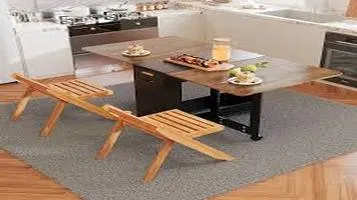Foldable Furniture: The Ultimate Space-Saving Solution
Foldable furniture is a versatile and space-saving solution ideal for modern living spaces. Designed to maximize functionality in compact areas, this innovative furniture can be easily folded, stored, or reconfigured according to the user's needs. Popular in urban apartments, tiny homes, and multi-purpose rooms, foldable furniture includes items like beds, tables, chairs, and desks that transform effortlessly to accommodate various activities. Made from durable materials such as metal, wood, and high-quality plastics, these pieces offer both style and practicality. They are perfect for those who frequently move or seek to declutter their living spaces without compromising on comfort. Foldable furniture combines contemporary design with flexibility, making it an essential choice for those valuing both aesthetics and functionality in their home environments.

In the ever-evolving world of interior design, one trend that has gained significant momentum in recent years is foldable furniture. As living spaces become smaller, especially in urban areas, the need for multifunctional and space-saving solutions has never been more critical. Foldable furniture offers a practical and stylish answer to this modern-day challenge, seamlessly blending form and function. This review delves into the various aspects of foldable furniture, exploring its advantages, potential drawbacks, and overall impact on contemporary living.
The Appeal of Foldable Furniture
One of the most compelling reasons to invest in foldable furniture is its ability to maximize space efficiency. In compact apartments or multifunctional rooms, every square inch counts. Foldable furniture, such as dining tables, chairs, beds, and desks, can be easily tucked away when not in use, freeing up valuable floor space. This flexibility is particularly advantageous for individuals living in studio apartments or small homes where space is at a premium.
Moreover, foldable furniture is not just about function; it's about style too. Modern designs have evolved significantly from the clunky, unattractive options of the past. Today, foldable furniture comes in a variety of sleek, contemporary designs that cater to different aesthetic preferences. Whether you prefer minimalist, industrial, or Scandinavian styles, there's likely a foldable furniture option that will seamlessly integrate into your home decor.
Practical Benefits
Foldable furniture is synonymous with versatility. A foldable dining table, for instance, can serve as a compact breakfast nook during the day and expand to accommodate guests for dinner parties in the evening. Similarly, a foldable desk can provide a dedicated workspace when needed and then be stored away to reclaim living space. This adaptability makes foldable furniture an excellent choice for those who need their living spaces to serve multiple purposes.
Another notable benefit is the ease of transport and storage. For those who move frequently, foldable furniture offers a lightweight and portable solution that can make the relocation process significantly less stressful. It’s also ideal for renters who may need to adapt to different living spaces over time.
Quality and Durability
While the concept of foldable furniture is inherently appealing, concerns about quality and durability are valid. The good news is that advancements in materials and engineering have significantly improved the sturdiness and longevity of foldable furniture. High-quality options made from robust materials like solid wood, metal, and durable plastics can offer the same level of reliability as their non-foldable counterparts.
However, it’s essential to be discerning when selecting foldable furniture. Not all products are created equal, and there can be a wide variance in quality. Investing in reputable brands and reading customer reviews can help ensure that you’re purchasing a product that will stand the test of time.
Potential Drawbacks
Despite its many advantages, foldable furniture is not without its challenges. One potential drawback is the need for regular folding and unfolding, which can be cumbersome for some users. Over time, the mechanical components involved in the folding process may also wear out, leading to potential maintenance issues.
Additionally, while foldable furniture can be highly functional, it may not always provide the same level of comfort as traditional furniture. For instance, a foldable bed may not offer the same support and cushioning as a standard mattress and bed frame. Therefore, it’s crucial to balance the need for space-saving with the need for comfort, especially for items like beds and seating that are used frequently.
Environmental Impact
Foldable furniture often has a smaller environmental footprint compared to traditional furniture. The use of fewer materials and the ability to transport more units in a single trip can contribute to reduced carbon emissions. Furthermore, many manufacturers are now focusing on sustainable materials and eco-friendly production processes, making foldable furniture an attractive option for environmentally conscious consumers.
Conclusion
Foldable furniture represents a smart, stylish, and sustainable solution for modern living. Its ability to adapt to various needs and spaces makes it an invaluable asset for those seeking to optimize their living environments. While there are some potential drawbacks to consider, the benefits far outweigh the negatives, making foldable furniture a worthwhile investment for many households.
As urban living spaces continue to shrink and the demand for versatile, multifunctional furniture grows, the popularity of foldable furniture is likely to increase. Whether you’re a city dweller looking to maximize a small apartment or simply someone who appreciates the flexibility and convenience that foldable furniture offers, there’s no denying that this innovative approach to home furnishings is here to stay.






